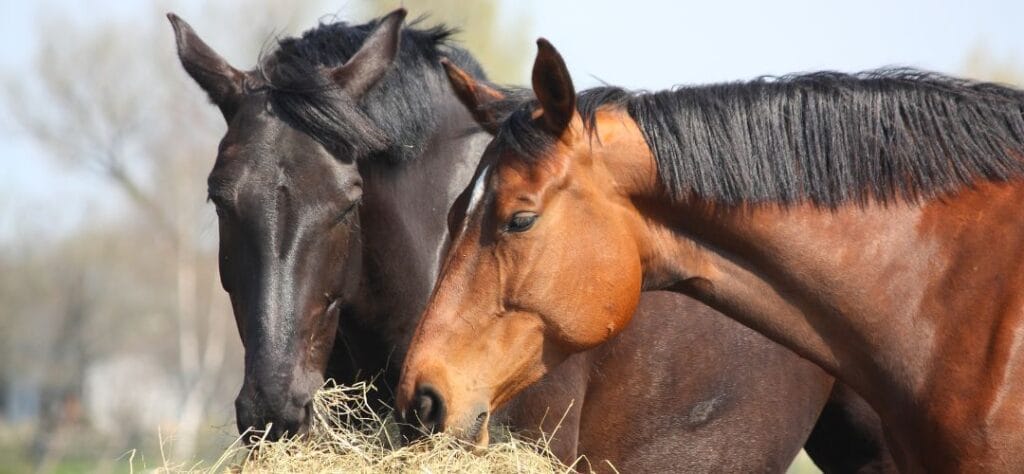In this article, we’ll explore proper equine nutrition, how to understand digestible energy (DE) requirements, how many calories a horse needs, forage options, concentrates and supplements.
Horses are natural grazers, and their digestive systems are designed for constant, balanced intake. That’s why understanding what goes into their feed and how it meets their nutritional needs, as well as the nutritional value of the ingredients, is crucial for maintaining a horse’s ideal body weight and overall health.
What Does a Balanced Diet Look Like for a Horse?
Whether your horse spends most of its time in the pasture or in the show ring, horse owners play a critical role in managing their horse’s diet. The National Research Council (NRC) is part of the U.S. National Academies of Sciences, Engineering and Medicine. It provides guidelines for determining nutrient requirements for a variety of animals, including equines. The NRC guidelines are often considered the gold standard for veterinarians and feed manufacturers in determining a horse’s energy needs, including digestible energy (DE) requirements.
A horse’s diet is also not a one-size-fits-all type of deal. It should be tailored to each horse’s individual needs, taking into account the horse’s age, breed and activity level.
A balanced diet for a horse looks like highly digestible fibers, a starch source, the right mix of vitamins and minerals, as well as forage sources. Typically, hay or pasture grass makes up the majority of what the average horse eats. Not only do they provide essential fiber, but they also keep the horse’s digestive system on track. Concentrates and supplements may help boost the horse’s diet, depending on its age, workload and overall health.
Paying attention to energy levels and even subtle changes in behavior are some of the best ways to fine-tune their feed plan and catch potential issues before they turn into bigger problems. That’s why being educated about your horse’s body health, dietary energy, and the risk of a calorie deficit in their feeding program is so important.
How to Determine a Horse’s Energy Needs
To calculate a horse’s energy needs, their maintenance energy requirements first need to be determined. These vary depending on the individual horse’s age, body weight and activity level.
While most nutritional guidelines are based on studies of light horse breeds, it’s important to remember that these are just general benchmarks. Some horses burn through calories quickly and need extra feed to maintain their weight. These are often referred to as “hard keepers.” Other equines may be ok on much less. These are known as “easy keepers.”
Amounts fed should be adjusted to maintain a body condition score between 4 and 7.
A body condition score (BCS) of 4 describes a horse that’s on the lean side. You might notice a slight ridge over the loin or a faint outline of the ribs, but the overall frame still looks healthy. The tailhead may be slightly prominent depending on the breed, though some fat should be easily felt. The hip bones (tuber coxae) aren’t sharply visible, and the withers, shoulders, and neck have a balanced appearance rather than looking thin.
A BCS of 7, on the other hand, indicates a fleshy horse. There may be a slight crease down the back, and the ribs are difficult to feel. You’ll also notice fat deposits along the withers, behind the shoulders and along the neck. While a score of 7 is still acceptable for many horses, carrying extra weight can reduce heat tolerance and make exercise more strenuous.
Additionally, horse owners should consider factors like grass hay, grass pasture, and concentrate feed when determining their horse’s energy needs. A veterinarian can help identify the ideal BCS for each horse in their herd.
Understanding Digestible Energy (DE)
Digestible energy (DE) is used to determine how many calories a horse needs to maintain weight, build muscle, and perform at its best, along with assessing their nutrient requirements. Digestible Energy refers to the amount of energy a horse can actually extract and use from its feed. A variety of factors can influence DE:
- The horse’s forage
- Type of feed (hay, grain, or pelleted mixes)
- The different characteristics of the horse itself (age, workload, temperament, and metabolism)
To determine DE requirements, the horse’s activity level and life stage need to be considered.
Horses that do casual riding or light training will need enough DE to maintain body condition and basic metabolic functions, such as digestion, body temperature, and circulation. As workload increases, so does energy demand. That’s why performance horses, growing young horses, and those recovering from illness or injury will need a higher DE intake.
Keeping a horse’s DE intake in check also helps prevent common health issues. For example, too little energy can result in weight loss, a poor coat, reduced performance, and fatigue. In contrast, too much DE can lead to obesity, laminiti,s and metabolic disorders, such as insulin resistance or equine metabolic syndrome.
In short, the horse needs enough fuel to support its daily activity and overall health without causing it to gain excess weight.
What Are The Best Forage Options?
Forage provides most of the horse’s calories, essential nutrients, and fibers.
Horses are natural grazers, designed to eat small amounts of forage throughout the day. Common types of forage include dry matter such as grass hay, legume hay, and fresh pasture grass. Grass hays are lower in protein and calories, but high in fiber, making them a good choice for easy keepers or horses at maintenance. Legume hays are the opposite. They tend to be richer in protein, calcium, and energy. This is recommended for growing horses, those with a heavy workload who need extra fuel, and broodmares.
A forage analysis is also important. It can reveal key information like crude protein, mineral levels, and fiber, helping identify whether the hay or pasture meets the horse’s nutritional requirements. In general, according to Merck Veterinary Manual, most horses should consume 1.5%–2% of their body weight in forage each day to maintain a healthy gut and steady energy levels.
Providing a variety of high-quality forages not only helps them get all the nutrients and mineral content they need, but it keeps horses happy, interested, and feeling their best.
Concentrate Feed
Concentrate feeds are an excellent way to fill any nutritional gaps as well as provide extra fuel for horses with higher energy demands. Concentrates can include:
- Grains
- Pelleted feeds
- Textured mixes designed to supply additional calories, protein, vitamins, and minerals
When choosing a concentrate, each horse is unique, and it’s essential to select a feed that’s balanced and tailored to your horse’s specific needs. Factors like energy density, protein content, vitamin and mineral balance, and even starch or sugar levels should all be considered. Reading feed bags or bag tags carefully and consulting with an equine nutritionist or veterinarian helps ensure you’re choosing the right formula for your horse’s workload and metabolism.
Beet Pulp and Other Supplements for a Balanced Equine Diet
Beet pulp is a commonly used fiber source in equine diets because it helps provide extra energy and fermentable fiber. For heavy workers, older horses with less efficient digestive systems, and horses that require more calories, beet pulp is a great choice. Beet pulp can be fed dry, or, when dealing with a horse experiencing dental issues, soaking is recommended. Beet pulp is highly digestible and helps maintain gut health while providing steady energy throughout the day.
Other supplements, such as rice bran and vitamin E, are also great options for increasing energy. Rice bran is a rich source of fat, helping maintain body condition without overloading the digestive system with starches. Vitamin E works as a powerful antioxidant, supporting immune function, overall well-being, and muscle health, especially in horses with limited access to fresh pasture.
Before adding supplements to a horse’s diet, it is strongly recommended to consult with an equine nutritionist or veterinarian who can help determine the right type and amount of supplement for a safe and balanced diet. If used too much, supplements can provide toxic levels of minerals and vitamins, an upset digestive system, and other issues. However, the goal is for them to enhance a foundation of high-quality forage for steady energy, improved performance, and optimal health.
Exercise Level and Energy Requirements To Keep in Mind
Feeding a horse is about understanding and meeting their unique energy and nutritional needs to support overall health, well-being, and performance. A balanced equine diet is built on high-quality forage, providing essential fiber, nutrients, and steady energy. Concentrates and supplements can fill gaps or provide extra fuel for horses with higher workloads and other factors.
A horse’s exercise level has a significant impact on their energy requirements, with exercising horses needing more calories than inactive horses. Horse owners should consider factors, such as exercise intensity, duration, and frequency, when determining their horse’s energy needs.
Understanding DE requirements, body condition, body weight, and factors like age, exercise level, and breed helps determine how many calories a horse needs. Properly tailored feeding, combined with regular monitoring of weight and body condition, ensures that horses maintain prime health, avoid deficiencies or excesses, and have the energy necessary for daily activity, workload, and performance.
A horse’s diet should be adjusted accordingly to ensure they are getting enough calories to support their exercise level. Additionally, regular monitoring of a horse’s weight and body condition score (BCS) helps ensure they are maintaining a healthy weight. At Seminole Feed, we know how important it is for your horse to maintain the correct BCS, and that deep understanding and insight guides every step of our product development.


